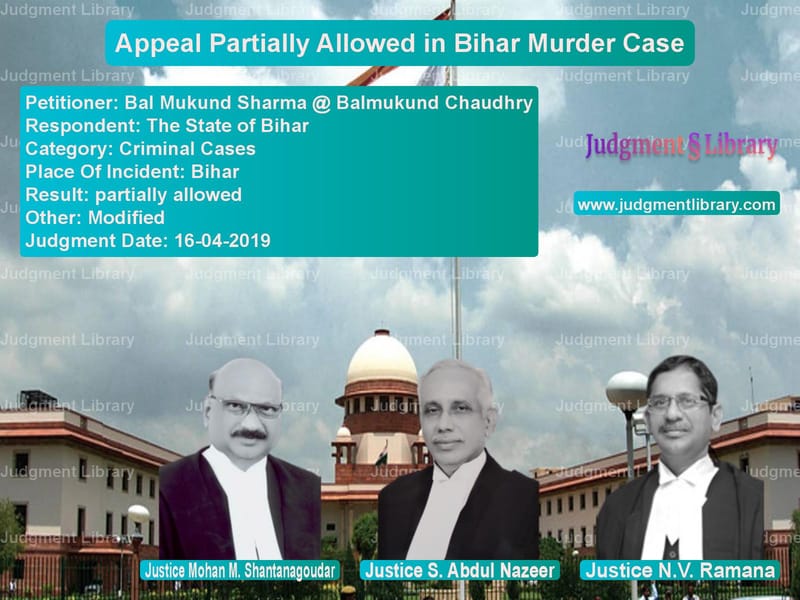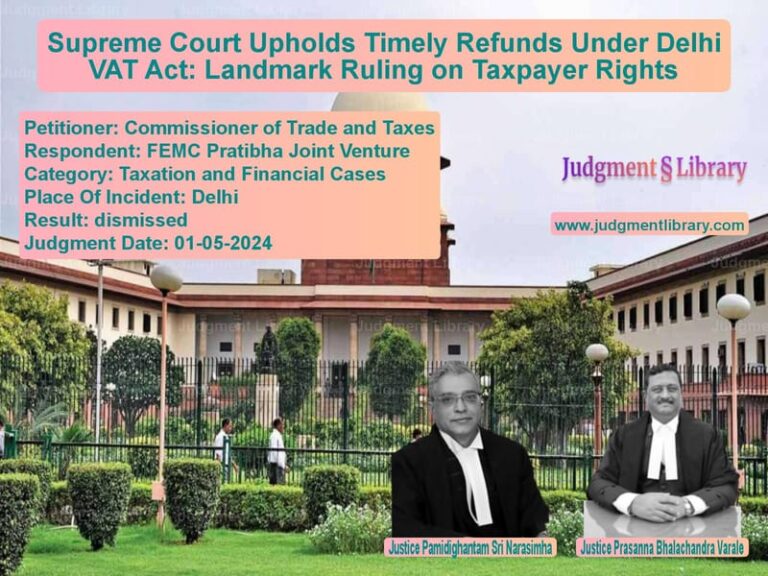Appeal Partially Allowed in Bihar Murder Case
This case concerns a tragic incident that occurred on the night of 13/14th September 1992 in Bihar, where a man named Ambika Pandit was murdered, and several others were injured in a violent attack. The case involves multiple accused individuals, and the issue at hand is whether the convictions against certain accused should stand or be overturned. The trial court had convicted a number of individuals, and these convictions were subsequently appealed to the High Court, which upheld most of the findings. However, some appeals were brought before the Supreme Court, which rendered its decision based on the analysis of the facts, evidence, and legal principles involved.
Background of the Case
The prosecution’s case revolves around an incident where the informant, Meghu Pandit (PW2), and his wife were attacked by a mob of 15 accused persons while they were carrying soil for the purpose of making earthen pots. During the attack, a number of violent acts occurred, including the shooting of the informant’s nephew, Ambika Pandit, by one of the accused, Brahamdeo Chaudhry. The accused also attempted to set the informant’s house on fire, and other villagers were injured in the process. Following the attack, the police were informed, and an FIR was registered.
The trial court convicted 7 individuals, including Brahamdeo Chaudhry and Kapildeo Chaudhry, under various sections of the Indian Penal Code (IPC), including Section 302 (murder) and Section 149 (unlawful assembly). The remaining accused were convicted for different offences, including rioting and attempted murder. However, the defense counsel argued that not all of the accused should have been convicted for the murder, and that there was insufficient evidence to hold some individuals responsible for the crime.
Key Arguments of the Parties
Appellants’ Arguments
- The appellants argued that the trial court and the High Court were wrong to convict all the 15 accused under Section 302 of the IPC. It was claimed that only Brahamdeo Chaudhry, who shot the deceased, should have been convicted for murder. The other accused were alleged to have participated in the riot, but not directly in the murder.
- The defense argued that the common object for the offence of murder was not proven against the other accused, and they should not have been convicted under Section 302 with the help of Section 149, IPC.
- The appellants also contested the sufficiency of the evidence, arguing that several of the accused were wrongfully implicated based on their proximity to Brahamdeo Chaudhry, who was the primary shooter. It was further argued that the prosecution had failed to provide specific evidence of their involvement in the murder.
Respondent’s (State’s) Arguments
- The prosecution contended that the evidence against the accused was sufficient to support their convictions. The informant and several injured eye-witnesses testified that they saw the accused, including Brahamdeo and Kapildeo Chaudhry, actively participating in the attack. Additionally, the prosecution argued that the unlawful assembly had a common object, which was to commit murder and other violent acts.
- The prosecution pointed out that although there were discrepancies in some witness testimonies, the overall evidence, including the firing by Brahamdeo Chaudhry, was enough to substantiate the charges of murder and rioting against the accused.
Supreme Court’s Analysis
The Supreme Court carefully analyzed the testimonies of the key witnesses, including the informant (PW2) and the injured witnesses (PWs 3 to 6). The Court found that Brahamdeo Chaudhry was the principal actor in the murder, having shot the deceased, Ambika Pandit. The Court also agreed with the trial court’s findings that Kapildeo Chaudhry and the other accused had played significant roles in the rioting, causing injuries to several villagers, including PW4 and PW5.
However, the Court noted that for the rest of the accused, there was insufficient evidence to conclusively prove their involvement in the murder. The Court observed that while these accused were part of the mob, their participation in the actual act of murder was not substantiated beyond a reasonable doubt. The Court emphasized that mere presence at the scene of a crime does not automatically imply guilt, and the prosecution needed to prove that these individuals had shared a common object to commit murder.
The Court also dealt with the legal principles of constructive liability under Section 149, IPC, noting that to convict someone under Section 302 with the help of Section 149, it must be shown that the person was part of the unlawful assembly with the common object of committing the offence. The Court ruled that while some of the accused were involved in the attack and caused injuries to others, there was no clear evidence linking them to the murder itself.
Judgment
The Supreme Court partially allowed the appeals, with the following modifications to the convictions:
- The conviction and sentence of Brahamdeo Chaudhry (Accused No. 9) under Section 302, IPC, for the murder of the deceased was upheld. His conviction for other offences was also confirmed.
- The conviction of Kapildeo Chaudhry was also upheld for his involvement in the rioting and firing, but the Court found insufficient evidence to convict him for the murder.
- The other accused—Mahendra Rai, Babulal Chaudhry, Bhavesh Chaudhry, and Anil Chaudhry—were acquitted of the charges of murder under Section 302/149, IPC. However, their conviction for other offences, such as rioting, was confirmed. Their sentences were modified to the period already undergone in jail.
- The remaining accused, including Balmukund Sharma @ Balmukund Chaudhry, Ashok Rai, Kishore Rai, Sunil Chaudhry, Mani Chaudhry, Pankaj Chaudhry, Sanjay Chaudhry, Manoj Chaudhry, and Sadanand Chaudhry, were acquitted of all charges against them due to lack of sufficient evidence.
Conclusion
This case highlights the importance of clear and credible evidence when determining the guilt of individuals involved in a crime. The Supreme Court’s ruling emphasizes that mere presence at a crime scene or involvement in a mob does not automatically implicate an individual in the commission of a specific offence, such as murder. The decision reinforces the principle that the prosecution must prove its case beyond reasonable doubt, particularly when applying constructive liability under Section 149, IPC.
Ultimately, the Court’s decision reflects a balance between holding individuals accountable for their roles in a crime while also safeguarding the rights of those who cannot be conclusively linked to the most serious charges.
Petitioner Name: Bal Mukund Sharma @ Balmukund Chaudhry.Respondent Name: The State of Bihar.Judgment By: Justice Mohan M. Shantanagoudar, Justice S. Abdul Nazeer, Justice N.V. Ramana.Place Of Incident: Bihar.Judgment Date: 16-04-2019.
Don’t miss out on the full details! Download the complete judgment in PDF format below and gain valuable insights instantly!
Download Judgment: Bal Mukund Sharma @ vs The State of Bihar Supreme Court of India Judgment Dated 16-04-2019.pdf
Direct Downlaod Judgment: Direct downlaod this Judgment
See all petitions in Murder Cases
See all petitions in Attempt to Murder Cases
See all petitions in Judgment by Mohan M. Shantanagoudar
See all petitions in Judgment by S. Abdul Nazeer
See all petitions in Judgment by N.V. Ramana
See all petitions in partially allowed
See all petitions in Modified
See all petitions in supreme court of India judgments April 2019
See all petitions in 2019 judgments
See all posts in Criminal Cases Category
See all allowed petitions in Criminal Cases Category
See all Dismissed petitions in Criminal Cases Category
See all partially allowed petitions in Criminal Cases Category







